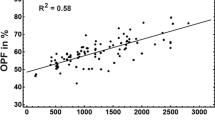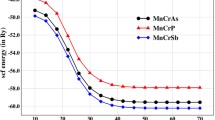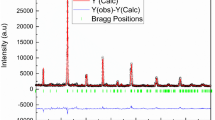Abstract
Specific heat measurements have been performed on polycrystalline HoCo2, ErCo2 and their solid solutions Ho1−x Er x Co2 (0.1≤x≤0.5). These compounds were synthesized using high-purity rare-earth metals and cobalt. X-ray diffraction patterns taken at room temperature reveal that all compounds have the C15 cubic Laves phase structure. Heat capacity measurements have been performed in the temperature range of 2–300 K without magnetic field and in a magnetic field of 1 and 2 T. The magnetocaloric effect has been estimated in terms of isothermal magnetic entropy change for all solid solutions in magnetic fields up to 2 T. The effect of increasing Er amount in Ho1−x Er x Co2 on the magnetic and magnetocaloric properties will be discussed.
Similar content being viewed by others
Avoid common mistakes on your manuscript.
1 Introduction
In recent years, the intermetallic compounds RCo2 (R = rare earth) belonging to the C15-type cubic Laves-phase crystal structure were the subject of extensive investigations because of their interesting intrinsic magnetic properties. A large magnetocaloric effect (MCE) observed in some of these compounds makes them suitable candidates for magnetic refrigeration technology [1, 2]. Attractive materials for magnetic refrigeration applications are compounds that display first-order magnetic phase transitions [3]. In this context, RCo2 intermetallic compounds are one of the promising candidates. It has been found that in the case of RCo2 with heavy rare-earth elements (R = Ho, Dy and Er) the ferrimagnetic–paramagnetic phase transitions are of first order and these compounds exhibit a large magnetic entropy change [4, 5]. In the RCo2 compounds the magnetic moment on the Co sites is induced by an exchange interaction with the rare-earth moments [6, 7]. The Co moments range from 0.5 to 0.8 μB in the light rare-earth compounds, while they are almost constant (∼1.0 μB) in the heavy rare-earth compounds. The induced moments are aligned parallel to the 4f moments in the light rare-earth compounds and antiparallel in the heavy rare-earth compounds [8]. From a large number of intermetallic compounds, HoCo2 and ErCo2 were selected and their Curie temperature is 75 and 32 K, respectively [9]. It should be noted that MCE properties of HoCo2 and ErCo2 were investigated. According to Tishin et al. [10] for HoCo2 the maximum ΔT ad at 84 K reaches 10 K for a field change μ0H of 10 T. Giguere et al. [11] reported the maximum ΔT ad=14.4 K for ErCo2 at 33 K for μ0H=14 T. In the case of Ho1−x Er x Co2 some theoretical calculation was performed by Oliveira et al. [12]. They have shown that the introduction of Er ions decreases the magnetic ordering temperature of the pseudobinary compounds and the nature of the magnetic phase transitions continues to be first-order for all Er concentrations.
In the present work, the influence of the partial replacement of Ho by Er in Ho1−x Er x Co2 solid solutions on the phase structure and MCE has been studied experimentally.
2 Experimental Details
Polycrystalline samples of Ho1−x Er x Co2 (0.1≤x≤0.5) solid solutions were prepared by arc-melting stoichiometric proportions of starting materials (of at least 99.9 % purity) on a water-cooled copper crucible under a high-purity argon atmosphere. The alloys were remelted four times to ensure good homogeneity. The mass losses after the melting were less than 1 wt%. The buttons obtained were wrapped in a tantalum foil, sealed in evacuated quartz ampules, and annealed at 700 °C for two weeks.
Specific heat measurements were performed in the temperature range of 2–300 K in applied magnetic fields of 1 and 2 T using Quantum Design PPMS 14 Heat Capacity System. X ray powder diffraction revealed that Ho1−x Er x Co2 samples are single phase and have the cubic C15 structure (space group Fd-3m). The lattice parameters decrease with increasing the Er content from 0.7171 for x=0.1 to 0.7164 for x=0.5.
3 Results and Discussion
The specific heat of Ho1−x Er x Co2 measured in zero magnetic field are shown as functions of temperature in Fig. 1. It can be seen that a sharp peaks associated with the first-order magnetic phase transitions were observed. The Curie temperatures decrease from 73 K in Ho0.9Er0.1Co2 down to 50 K in Ho0.5Er0.5Co2. Specific heat measurements in a magnetic field show that the maximum C p (T) peaks shifted to higher temperatures, and were gradually decreases with increasing magnetic field (see inset of Fig. 1). Moreover for the samples with x≤0.4 additional relatively small and smooth step-like increase in C p (T) plots at the low-temperature region is observed. One possible mechanism for the low-temperature transition might be a spin reorientation in the Ho(Er) 4f subsystem similar to that observed in HoCo2 (T SR=15 K) and NdCo2 (T SR=43 K) [13]. In those two compounds it is assumed that the spin reorientation is driven by an interplay of molecular and crystal fields, thus giving rise to the change of the easy direction of magnetization from [1 0 0] to [1 1 0] with decreasing temperature. The substitution of Er for Ho in Ho1−x Er x Co2 results in the increase in the spin-reorientation temperatures from 24 for x=0.1 to 45 for x=0.4. The spin-reorientation transition, observed in Ho1−x Er x Co2 with a maximal 40 % substitution of Er for Ho can be understood as an effect of the competition between the magnetocrystalline anisotropy of the Co and Ho(Er) sublattices.
The relatively low Curie temperature and spin-reorientation effect does not allow for an accurate determination of the electronic heat capacity coefficient γ and Debye temperature Θ D in the low-temperature range. In order to estimate the magnetic contribution a theoretical calculation of the Debye function was made. The fitting was performed according to the formula [14]:
where the first term represents the electronic heat capacity and the second term corresponds to the phonon Debye contribution; N=3 is the number of atoms per formula unit; R is the universal gas constant; and x≡ħω/k B T.
The best fit for the wide temperature range could be obtained by fixing the parameters γ=30 mJ/mol K2 for all the measured samples, while the Debye temperature increases from 240 to 280 K with the increase of Er content.
The magnetic part of the entropy S mag was calculated by integrating C mag(T)/T. Figure 2 shows, as example, the temperature variation of the magnetic entropy in zero, 1 and 2 T magnetic fields for Ho0.9Er0.1Co2. S mag increases with increasing temperature and, as expected, the application of the magnetic field leads to the decrease of S mag in the vicinity of T C. For Ho0.9Er0.1Co2 the magnetic entropy reach the maximum values 26.5 J/mol K in the temperature ∼200 K. In the case of parent compounds it was found that experimental values of the magnetic entropy of HoCo2 and ErCo2 at 200 K are 24 and 23.1 J/mol K, respectively [6, 15]. This fact indicates that the magnetic entropy is determined by Ho(Er) moments and that the Co moments make a small contribution to the total S mag.
The magnetocaloric effect was calculated by a method suggested by von Ranke et al. [16]. Figure 3 shows the temperature dependence the adiabatic temperature change ΔT ad(T) for all measured solid solutions at a magnetic field of 1 and 2 T. The maximum peak value decreases with increasing Er content. As expected, the magnetic field leads to an increase of ΔT ad. The maximum ΔT ad reaches about 7 K near 73 K for Ho0.9Er0.1Co2 and decreases to about 6 K near 50 K for Ho0.5Er0.5Co2 (magnetic field of 2 T). The sharp peaks in the ΔT ad curves are related to the ferrimagnetic–paramagnetic phase transition at the Curie point, where the magnetization change is maximal.
4 Conclusion
The effect of the partial replacement of Ho by Er in Ho1−x Er x Co2 solid solutions on the structure and physical properties has been studied. It was confirmed that the main phase in all solid solutions is cubic C15 structure. The substitution of Er in Ho1−x Er x Co2 results in the increase in the temperatures T SR and decrease in T C, as observed in the specific heat measurements. The T SR temperature increases from 24 K to 45 K, and T C decreases from 73 K to 50 K. The maximum MCE estimated in terms of isothermal magnetic entropy change reaches 7 K (magnetic field of 2 T) for x=0.1 and is highly attractive for magnetic cooling applications.
References
Singh, N.K., Suresh, K.G., Nigam, A.K., Malik, S.K., Coelho, A.A., Gama, S.: J. Magn. Magn. Mater. 317, 68 (2007)
von Ranke, P.J., Grangeia, D.F., Caldas, A., de Oliveira, N.A.: J. Appl. Phys. 93, 4055 (2003)
Foldeaki, M., Giguere, A., Chahine, R., Bose, T.K.: Adv. Cryog. Eng. 43, 1533 (1998)
Duc, N.H., Kim Anh, D.T.: J. Magn. Magn. Mater. 873–875, 242 (2002)
Wang, D.H., Tang, S.L., Liu, H.D., Gao, W.L., Du, Y.W.: Intermetallics 10, 819 (2002)
Voiron, J., Berton, A., Chaussy, J.: Phys. Lett. A 50, 17 (1974)
Gignoux, D., Givord, F., Koehler, W.C.: Physica 86-88B, 165 (1977)
Bloch, D., Edwards, D.M., Shimizu, M., Voiron, J.: J. Phys. F 5, 1217 (1975)
Kirchmayr, H.R., Burzo, E.: In: Wijn, H.P.J. (ed.) Landolt Börnstein, New Series III/19d2, Berlin (1990)
Tishin, A.M., Spichkin, Y.I.: The Magnetocaloric Effect and Its Applications. IOP Publishing, Bristol (2003)
Giguere, A., Foldeaki, M., Schnelle, W., Gmelin, E.: Phys. Rev. B, Condens. Matter Mater. Phys. 11, 6969 (1999)
de Oliveira, N.A.: Eur. Phys. J. B 65, 207 (2008)
Gratz, E., Nowotny, H.: J. Magn. Magn. Mater. 29, 127 (1982)
Bouvier, M., Lethuillier, P., Schmitt, D.: Phys. Rev. B 43, 13137 (1991)
Imai, H., Wada, H., Shiga, M.: J. Magn. Magn. Mater. 140–144, 835 (1995)
von Ranke, P.J., Grangeia, D.F., Caldas, A., de Oliveira, N.A.: J. Appl. Phys. 93, 4055 (2003)
Open Access
This article is distributed under the terms of the Creative Commons Attribution License which permits any use, distribution, and reproduction in any medium, provided the original author(s) and the source are credited.
Author information
Authors and Affiliations
Corresponding author
Rights and permissions
Open Access This article is distributed under the terms of the Creative Commons Attribution 2.0 International License (https://creativecommons.org/licenses/by/2.0), which permits unrestricted use, distribution, and reproduction in any medium, provided the original work is properly cited.
About this article
Cite this article
Ćwik, J., Palewski, T. & Nenkov, K. Specific Heat and Magnetocaloric Effect in Ho-Er-Co Solid Solutions. J Supercond Nov Magn 26, 183–186 (2013). https://doi.org/10.1007/s10948-012-1708-9
Received:
Accepted:
Published:
Issue Date:
DOI: https://doi.org/10.1007/s10948-012-1708-9







